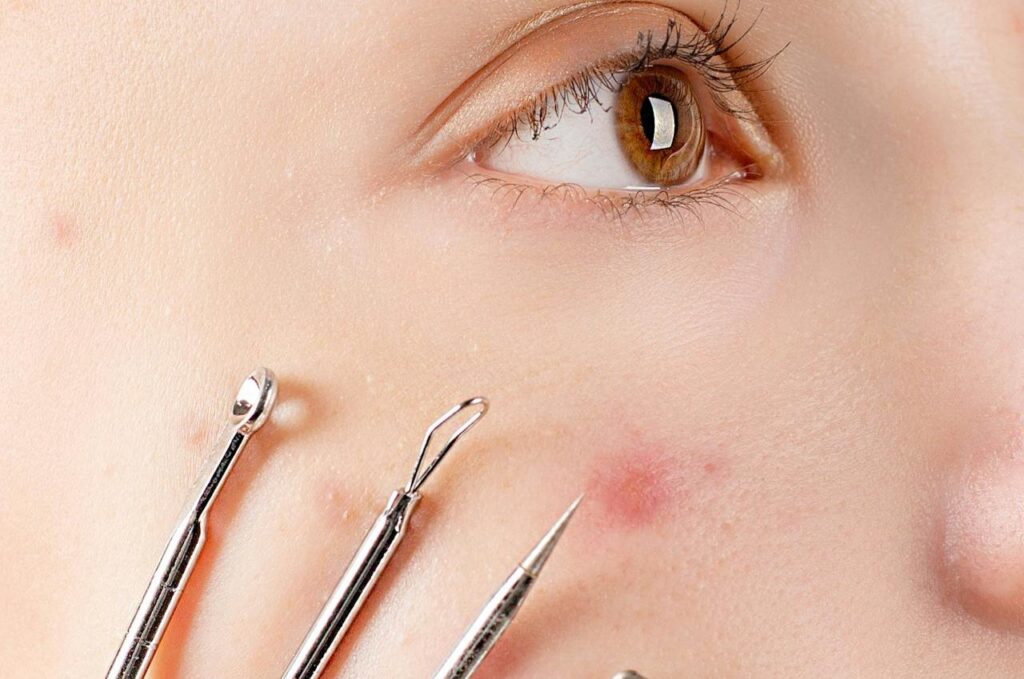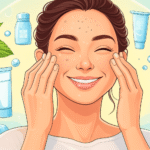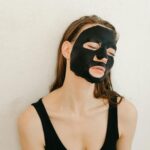Blackheads are one of the most persistent and frustrating skin concerns, affecting millions of people regardless of age or skin type. These dark, stubborn spots form when pores become clogged with dead skin cells, excess oil (sebum), and bacteria, which then oxidize when exposed to air, creating their characteristic dark appearance. Unlike whiteheads, blackheads have an open surface, making them particularly visible and challenging to treat.
Understanding how to effectively eliminate blackheads requires a comprehensive approach that combines proven treatments, proper prevention strategies, and personalized care based on your unique skin type. This guide presents 12 dermatologist-approved methods to help you achieve clearer, healthier skin while avoiding common mistakes that can worsen the problem.
1. Start with Salicylic Acid Cleansing
Salicylic acid is the gold standard for blackhead treatment, and for good reason. This beta-hydroxy acid (BHA) is oil-soluble, allowing it to penetrate deep into pores and break down the keratin plugs that form blackheads. Unlike water-soluble acids that only work on the skin’s surface, salicylic acid can dissolve the sebum and dead skin cells that clog your pores from within.
How to Use Salicylic Acid Effectively:
- Start with a 0.5% to 2% concentration for daily use
- Apply to clean, dry skin before moisturizer
- Begin with every other day to build tolerance
- Always follow with SPF during the day, as BHAs increase sun sensitivity
Look for cleansers, toners, or leave-on treatments containing salicylic acid. Consistency is key – most people see results after 6-8 weeks of regular use.
2. Incorporate AHA and BHA Exfoliation
Alpha-hydroxy acids (AHAs) like glycolic and lactic acid work synergistically with BHAs to provide comprehensive exfoliation. While salicylic acid targets oil-based clogs, AHAs remove dead skin cells from the surface, preventing them from mixing with sebum to form new blackheads.
Best Practices for Chemical Exfoliation:
- Use AHAs in the evening (they increase photosensitivity)
- Alternate between AHA and BHA products to avoid over-exfoliation
- Start with lower concentrations (5-10% for AHAs)
- Never use physical scrubs on the same day as chemical exfoliants
This dual approach addresses both the surface buildup and deep pore congestion that contribute to blackhead formation.
3. Add a Gentle Skin Brush to Your Routine
Facial cleansing brushes can enhance your blackhead-fighting routine when used correctly. These tools provide gentle physical exfoliation that helps remove surface debris and can improve the penetration of your chemical exfoliants.
Choosing and Using a Skin Brush:
- Opt for soft, synthetic bristles over natural ones
- Use circular motions for no more than 30 seconds
- Clean your brush thoroughly after each use
- Limit use to 2-3 times per week to prevent irritation
Remember, the brush should complement, not replace, your chemical exfoliation routine.
4. Try Topical Retinoids for Long-Term Results
Retinoids, including over-the-counter retinol and prescription tretinoin, are powerful allies in the fight against blackheads. These vitamin A derivatives increase cell turnover, preventing dead skin cells from accumulating in pores while also reducing oil production over time.
Retinoid Application Tips:
- Start with a low concentration (0.25% retinol or 0.025% tretinoin)
- Apply only at night, as retinoids break down in sunlight
- Use a pea-sized amount for your entire face
- Expect an adjustment period of 4-6 weeks
Retinoids provide long-term benefits beyond blackhead removal, including improved skin texture and reduced signs of aging.
5. Harness the Power of Clay Masks
Clay masks are excellent for drawing out excess oil and impurities from pores. Bentonite and kaolin clays are particularly effective for blackhead-prone skin, as they absorb sebum without over-drying.
Maximizing Clay Mask Benefits:
- Use 1-2 times per week on clean skin
- Apply a thin, even layer avoiding the eye area
- Remove while still slightly damp to prevent over-drying
- Follow with a hydrating moisturizer
Clay masks work best as part of a comprehensive routine rather than as standalone treatments.
6. Consider Charcoal Masks for Deep Cleansing
Activated charcoal has gained popularity for its ability to bind to toxins and impurities. While the science is still emerging, many people find charcoal masks helpful for reducing the appearance of blackheads, particularly in the T-zone.
Using Charcoal Masks Safely:
- Choose products with additional beneficial ingredients like hyaluronic acid
- Limit use to once per week to prevent over-drying
- Patch test first, as some people are sensitive to charcoal
- Never use DIY charcoal masks, which can be too harsh
7. Explore Professional Chemical Peels
For stubborn blackheads that don’t respond to at-home treatments, professional chemical peels can provide more intensive exfoliation. Dermatologists can customize peel strength and type based on your skin’s needs.
Types of Professional Peels for Blackheads:
- Light peels: Glycolic or lactic acid (minimal downtime)
- Medium peels: TCA (trichloroacetic acid) for deeper penetration
- Combination peels: Multiple acids for comprehensive treatment
Professional peels should always be performed by licensed practitioners and require proper aftercare.
8. Choose Noncomedogenic Products Exclusively
The term “noncomedogenic” means a product is formulated to not clog pores. This is crucial for blackhead-prone skin, as even beneficial ingredients can worsen the problem if they’re too heavy or occlusive.
Key Noncomedogenic Ingredients to Look For:
- Hyaluronic acid for hydration
- Niacinamide for oil control and pore appearance
- Ceramides for barrier repair
- Zinc oxide for sun protection
Always check product labels and avoid heavy oils, petroleum-based ingredients, and thick creams if you’re prone to blackheads.
9. Perfect Your Makeup Removal Routine
Sleeping in makeup is one of the fastest ways to develop blackheads. Makeup, especially foundation and concealer, can mix with natural oils and dead skin cells to create the perfect environment for pore clogging.
Effective Makeup Removal Steps:
- Use an oil-based cleanser or micellar water first
- Follow with a gentle, water-based cleanser
- Use a soft cloth or cotton pad, never harsh scrubbing
- Pay extra attention to areas where makeup tends to accumulate
This double-cleansing method ensures complete removal of all makeup and impurities.
10. Understand Your Skin Type for Personalized Care
One significant gap in many blackhead guides is the lack of personalized advice based on skin type. Your approach should vary depending on whether you have oily, combination, sensitive, or mature skin.
Skin Type-Specific Strategies:
- Oily skin: Can tolerate stronger concentrations and more frequent treatments
- Combination skin: Focus treatments on the T-zone while being gentler on dry areas
- Sensitive skin: Start with lower concentrations and fewer active ingredients
- Mature skin: Combine anti-aging ingredients with blackhead treatments
11. Address Hormonal Factors
Hormonal fluctuations significantly impact blackhead formation, particularly during puberty, menstruation, pregnancy, and menopause. Understanding these patterns can help you adjust your routine accordingly.
Managing Hormonal Blackheads:
- Track your skin changes with your menstrual cycle
- Consider hormonal treatments if appropriate (consult a dermatologist)
- Adjust your routine intensity based on hormonal fluctuations
- Be patient, as hormonal skin issues often require longer treatment periods
12. Know When to See a Professional
While many blackheads can be managed at home, some situations require professional intervention. Dermatologists have access to stronger treatments and can perform safe extractions when necessary.
Signs You Need Professional Help:
- Blackheads persist after 8-12 weeks of consistent treatment
- You experience severe irritation from over-the-counter products
- Blackheads are accompanied by inflammatory acne
- You have very large or deeply embedded blackheads
Professional treatments may include prescription retinoids, stronger chemical peels, or specialized extraction techniques.
What NOT to Do: Common Blackhead Mistakes
Avoiding these common mistakes is just as important as following the right treatments:
- Never squeeze or pick at blackheads – This can cause scarring and spread bacteria
- Don’t use pore strips regularly – They can damage skin and only provide temporary results
- Avoid over-cleansing – This can trigger increased oil production
- Skip harsh physical scrubs – These can irritate skin and worsen blackheads
- Don’t expect overnight results – Consistent treatment over weeks is necessary
The Role of Diet and Lifestyle
Emerging research suggests that diet may play a role in blackhead formation. While more studies are needed, some evidence points to certain foods potentially worsening acne and blackheads:
Dietary Considerations:
- High-glycemic foods: May increase oil production
- Dairy products: Particularly skim milk, may worsen acne in some people
- Omega-3 fatty acids: May help reduce inflammation
- Hydration: Proper water intake supports overall skin health
Creating Your Personalized Blackhead Treatment Plan
Success in treating blackheads comes from creating a consistent, personalized routine:
Week 1-2: Foundation Building
- Introduce a salicylic acid cleanser
- Establish proper makeup removal habits
- Begin using noncomedogenic products
Week 3-4: Adding Active Ingredients
- Introduce AHA exfoliation 2-3 times per week
- Add a clay mask once weekly
- Monitor skin response and adjust frequency
Week 5-8: Optimization
- Consider adding retinoids if tolerated
- Evaluate progress and adjust concentrations
- Add professional treatments if needed
Week 9+: Maintenance
- Continue successful treatments
- Adjust routine based on hormonal changes
- Regular dermatologist check-ins if needed
Frequently Asked Questions
Q: How long does it take to see results from blackhead treatments?
A: Most people begin seeing improvements after 4-6 weeks of consistent treatment, with optimal results typically achieved after 8-12 weeks.
Q: Can I use multiple blackhead treatments at the same time?
A: Yes, but introduce them gradually to avoid irritation. Start with one active ingredient and add others slowly, monitoring your skin’s response.
Q: Are blackheads the same as sebaceous filaments?
A: No, sebaceous filaments are normal, hair-like structures that help oil flow to the skin surface. They’re lighter in color and return quickly after extraction, unlike true blackheads.
Q: Why do my blackheads keep coming back?
A: Blackheads recur because the underlying factors (oil production, dead skin cell buildup, pore structure) haven’t changed. Consistent, long-term treatment is necessary for ongoing control.
Q: Is it safe to extract blackheads at home?
A: While professional extraction is safest, if you must extract at home, use proper tools, sterilize everything, and only attempt it on superficial blackheads. Never force extraction.
Take Action for Clearer Skin Today
Achieving blackhead-free skin requires patience, consistency, and the right combination of treatments for your unique skin type. Start with the gentler methods outlined in this guide, gradually building your routine while monitoring your skin’s response. Remember that what works for others may not work for you, so be prepared to adjust your approach based on your results.
If you’re struggling with persistent blackheads despite following these guidelines, don’t hesitate to consult with a dermatologist. Professional guidance can help you navigate more advanced treatments and create a truly personalized skincare plan.
Your journey to clearer skin starts with the first step – choose one or two methods from this guide and begin implementing them consistently. With time and the right approach, you can achieve the clear, healthy skin you’ve been working toward.




Pingback: What's Causing the Blackheads on My Chin and How Do I Treat Them? - wholesomefed